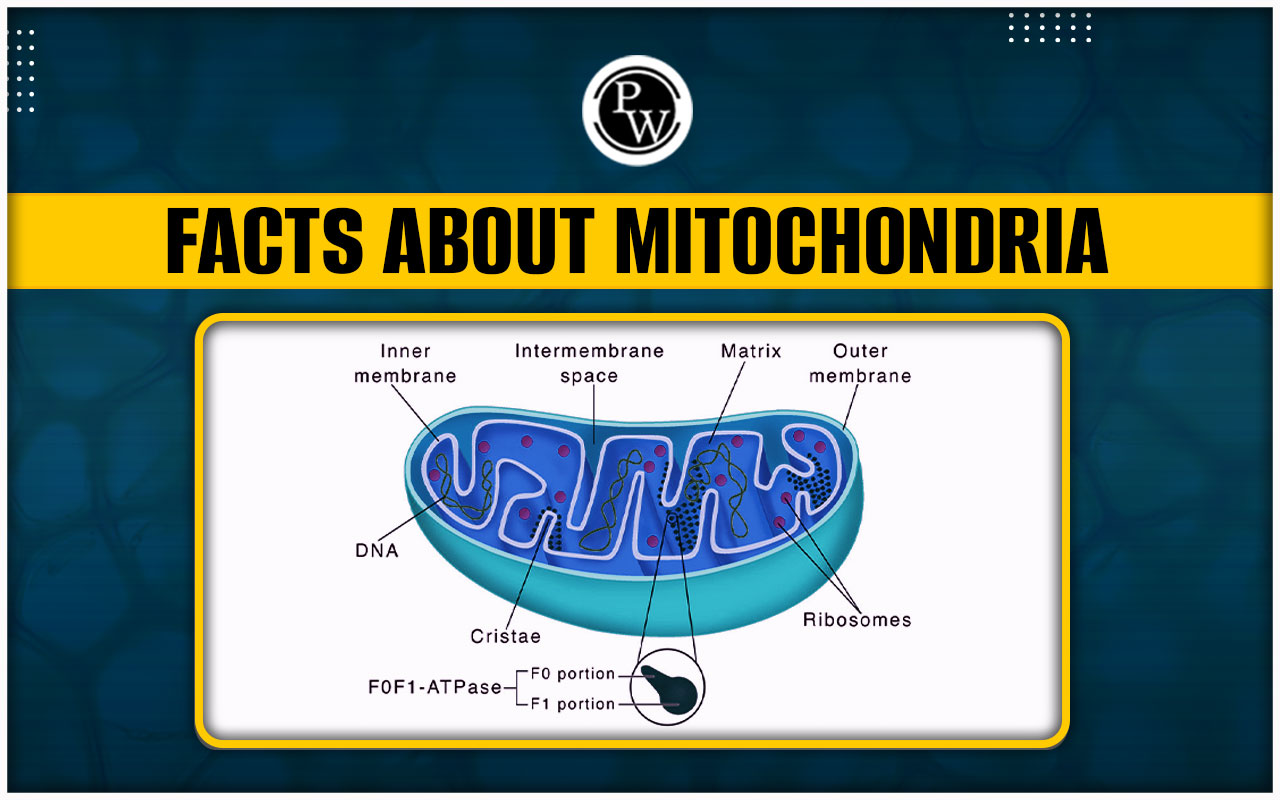

If you are looking for Facts About Mitochondria , you have come to the right place!
The topic “Facts About Mitochondria” will be covered in this article. The mitochondria, which are membrane-bound cell organelles, generate most of the chemical energy needed to power a cell's metabolic processes (mitochondrion, singular). Adenosine triphosphate, a tiny molecule, serves as a storage space for the chemical energy generated by the mitochondria (ATP). There are little chromosomes similar to those found in mitochondria. Typically, only the mother can pass on mitochondria and, by extension, mitochondrial DNA. The article will discuss the facts, structure and role of mitochondria.Introduction
All aerobic species, including plants, animals, and other eukaryotic organisms, have mitochondria, a double-membrane-bound, bean-shaped, colourless organelle. They are free-floating organelles in the cytoplasm, the cell's digestive system. They are crucial in nutrition breakdown and the production of molecules packed with energy for the cell. Within the mitochondria, several metabolic processes related to cellular respiration take place. German physician Richard Altmann originally described mitochondria in 1890; the name "mitochondrion" is derived from a Greek word that means "threadlike granules." The mitochondrial cell organelles are typically inherited solely from the mother, according to studies and research. More fascinating and incredible facts about mitochondria are detailed in the points below.Facts About Mitochondria
- The production of ATP molecules, the cell's primary energy source, is carried out by mitochondria, referred to as the "powerhouse" of the cell.
- Mitochondria are double-membrane, rod-shaped cell organelles with a unique structure and perform various specialised tasks. Both plant and animal cells have these organelles, which generate energy for cellular processes.
- With ribosomes, mitochondria can also produce their proteins.
- Different numbers of mitochondria are present depending on the cell's energy needs. The number of mitochondria is particularly high in cells whose metabolism uses more energy.
- Only muscle cells have a large number of mitochondria. This is primarily due to the muscles' increased energy needs for movement and other muscular functions. The mitochondria provide the necessary energy.
- Apoptosis, another name for programmed cell death, typically starts in the mitochondria. Apoptosis, managing the cell cycle, cell proliferation, and detoxifying ammonia in the liver cells are further specialised functions.
- Any deviation from normal mitochondrial function may directly impact human health. Different people experience mitochondrial diseases in different ways. Examples of mitochondrial illnesses include Alpers disease and Barth syndrome.
- Some bacteria and mitochondria have many similarities. Because these cell organelles contain a double-layered membrane made of lipids, precisely like the membrane of prokaryotes, and because they contain their DNA, which is contained in the matrix.
- Each cell has a unique number of mitochondria. The only cells in the human body without mitochondria are red blood cells. Numerous mitochondria can be found in other cells, such as liver and muscle cells.
- The functions of mitochondria influence their size and form. Mitochondria swiftly adapt their forms to the energy demands of the cells. The mitochondria divide and enlarge as the cell requires more energy to function.
Environmental Issues and Solutions
Structure of Mitochondria
Animal mitochondria are either circular or oval and are connected by two membranes. Proteins and phospholipid bilayers make up these membranes. In animal cells, the many mitochondrial components include- Outer Membrane: The inner organelles are kept whole and positioned by the outer membrane. Protein and phospholipid bilayers make up its structure. The enzymes engaged in numerous actions are found in the outer membrane. Ions, ATP, ADP, and other molecules can easily move through this membrane since this layer is also permeable to macromolecules.
- Inner Membrane: Proteins with various roles make up the inner membrane of the mitochondria. It also possesses the requisite enzymes that catalyse the processes required to create ATP. Water, carbon dioxide, and oxygen can pass through the inner mitochondrial membrane. The primary location for ATP production is the inner mitochondrial membrane. The inner mitochondrial membrane features numerous folds termed Cristae to expand the surface area.
- Inter Membrane Space: The intermembrane space is between the outer and inner membranes. Since these molecules can pass through the outer membrane enclosing it, this area also contains tiny molecules like ions and carbohydrates.
- Cristae : The mitochondria's inner membrane is folded several times. Cristae are the name for these folds. The cristae enhance the surface area inside the mitochondrial membrane for effective ATP molecule synthesis. The more surface area there is, the more room there is for cellular activities. Exosomes are adhered to the cristae's surface, aiding in the osmosis of ions.
- Matrix : The area in the inner membrane of the matrix that is not a crista. Proteins, ribosomes, enzymes, tRNA, and genomic DNA are all in this fluid. The Mitochondrial Matrix can create RNA and proteins because genetic material is present. Without the matrix enzymes that support the most crucial chemical cycles, ATP production would be insufficient.
Role of Mitochondria
Although energy production is the function of mitochondria that is most well-known, they also perform other crucial functions. Only roughly 3% of the genes required to create a mitochondrion are found in its energy-generating machinery. Most of them are engaged in additional tasks unique to the cell type in which they are present.Producing Energy
Because it drives metabolic processes, ATP, a complex organic molecule in all living things, is frequently referred to as the molecular equivalent of money. The Krebs cycle, or the citric acid cycle, is a set of reactions that produces the bulk of ATP in mitochondria. Most energy is generated in the cristae, or folds, of the inner membrane. Mitochondria convert chemical energy from the food we eat into an energy source the cell may use. This procedure is referred to as oxidative phosphorylation.Cell Death
Cell death, also known as apoptosis, is essential to life. When cells deteriorate or break, they are removed and killed. Mitochondria have a role in cell death decision-making. Cytochrome C, released by mitochondria, activates caspase, one of the main enzymes responsible for cell death during apoptosis. Mitochondria are thought to have a role in the disease since certain illnesses, including cancer, exhibit a breakdown in normal apoptosis.Storing Calcium
For several biological processes to work, calcium is necessary. For instance, the reintroduction of calcium into a cell may result in the release of neurotransmitters or hormones from the neuron or endocrine cells. Furthermore, calcium is necessary for blood clotting, fertilisation, and muscle function. The cell has very strict control over calcium because of its significance. Mitochondria play a role in swiftly collecting calcium ions and storing them until required. Calcium also controls cellular metabolism, steroid production, and hormone communication in the cell.Heat Production
We shudder to stay warm when we are cold. However, there are additional ways for the body to produce heat, one of which is through utilising a tissue known as brown fat. Mitochondria are capable of producing heat via a process known as proton leak. Non-shivering thermogenesis is the term for this. When we are young and more prone to colds, brown fat is present in the highest concentrations, and as we age, levels gradually decline.Related Links -
Facts About Mitochondria FAQs
Q1. Why are the mitochondria dubbed the "powerhouse"?
Ans. Energy from food is released by the mitochondria, which are cellular organelles. This process is known as cellular respiration. Therefore, mitochondria are commonly called the "powerhouses" of the cell.
Q2. Why are there more mitochondria in some cells?
Ans. Different cells have different numbers of mitochondria because some cells need more energy than others. Thus, the liver, kidney, and muscle all have a relatively limited number of mitochondria, as does the brain, whose function depends on the energy these mitochondria produce.
Q3. Why are mitochondria such a big deal?
Ans: In almost every human cell, as well as those of animals, plants, and fungi, mitochondria are the energy generators that power cellular activity and almost every aspect of our biological processes.
Q4. What causes mitochondria to get larger?
Ans. Studies in the journal “Experimental Physiology” show that the mitochondrial volume density (the proportion of muscle fibre volume filled by mitochondria) might rise by as much as 40% in response to endurance exercise.
Q5. Which foods are harmful to mitochondria?
Ans. Wahls advises avoiding meals containing gluten, dairy items, eggs, processed meats containing nitrates, and anything sweetened with sugar to maintain general and mitochondrial health. Wahls also suggests avoiding all grains, beans, peanuts, and soy for anyone concerned about their health.
🔥 Trending Blogs
Talk to a counsellorHave doubts? Our support team will be happy to assist you!

Check out these Related Articles
Free Learning Resources
PW Books
Notes (Class 10-12)
PW Study Materials
Notes (Class 6-9)
Ncert Solutions
Govt Exams
Class 6th to 12th Online Courses
Govt Job Exams Courses
UPSC Coaching
Defence Exam Coaching
Gate Exam Coaching
Other Exams
Know about Physics Wallah
Physics Wallah is an Indian edtech platform that provides accessible & comprehensive learning experiences to students from Class 6th to postgraduate level. We also provide extensive NCERT solutions, sample paper, NEET, JEE Mains, BITSAT previous year papers & more such resources to students. Physics Wallah also caters to over 3.5 million registered students and over 78 lakh+ Youtube subscribers with 4.8 rating on its app.
We Stand Out because
We provide students with intensive courses with India’s qualified & experienced faculties & mentors. PW strives to make the learning experience comprehensive and accessible for students of all sections of society. We believe in empowering every single student who couldn't dream of a good career in engineering and medical field earlier.
Our Key Focus Areas
Physics Wallah's main focus is to make the learning experience as economical as possible for all students. With our affordable courses like Lakshya, Udaan and Arjuna and many others, we have been able to provide a platform for lakhs of aspirants. From providing Chemistry, Maths, Physics formula to giving e-books of eminent authors like RD Sharma, RS Aggarwal and Lakhmir Singh, PW focuses on every single student's need for preparation.
What Makes Us Different
Physics Wallah strives to develop a comprehensive pedagogical structure for students, where they get a state-of-the-art learning experience with study material and resources. Apart from catering students preparing for JEE Mains and NEET, PW also provides study material for each state board like Uttar Pradesh, Bihar, and others
Copyright © 2025 Physicswallah Limited All rights reserved.











